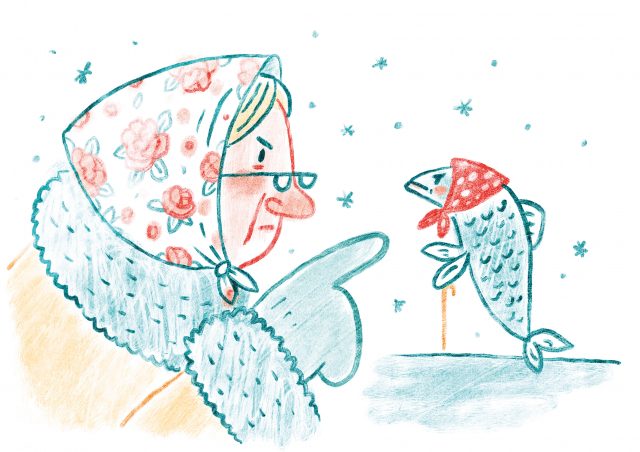The writer Yulia Verba has recently published a very funny book of short stories “Spawn of the Moldavanka” set in the dilapidated communal courtyards of the working class Odessa neighborhood of Moldavanka. Historically, the Moldavanka (named for migrants from Moldova) has always been a melting pot, a cramped living space through which generations of immigrants passed on their way to assimilating into the society, a place where new slang was cobbled together out of the spare parts of the many languages that were spoken by the people who lived there. The unique language of the Moldavanka is based on jazzy improvisational colloquialisms fashioned into a panoply of multilingual slang. Another story from the collection, “Tolerance” appeared in the last issue of The Odessa Review. An English language edition of the book is currently being prepared by the Odessa Review press and is forthcoming.
Moldavanka always prepared for New Year’s Eve in advance, long before the actual date. The most experienced people — like my great-grandmother Zhenya, who had lived through the Intervention (Ed: World War I was followed by foreign invasion of Soviet Union amid the civil war period) the occupation (Ed: Romanian occupation of Odessa during World War 2)— started getting ready in the middle of October. Their unlucky ‘Saratov’ and ‘Dnepr’ (Ed: ancient Soviet refrigerator brands) ice boxes stood with their little doors cracked open, oozing freon into the atmosphere. Because if you freeze blood sausage, balyk, goose and shank, the taste won’t be affected — especially after the second shot of vodka — and you can save half the cost, to say nothing of avoiding the stress of navigating the Privoz bazaar.
Nila solemnly introduced us to the subtleties of the New Year’s celebration: only real “meshuggeners” go shopping at the bazaar after the 24th of December. Only lunatics. You can go to the supermarket to buy some bread, oil or sparkling water. As a last resort, if you wake from a coma or get out of prison in December, go to the market on the 30th because kolkhoz farmers and illegal profiteers will also want to get home as quickly as possible and you’ll be able to haggle. Yes, I was also taught to haggle. Each of grandma’s trips to the market was pure stand-up comedy. “Are you sure that this is a chicken’s liver? I think your chicken abused alcohol or was a real pig. How much for this very tired, elderly herring?”
Today I have my own trademark and — most importantly — honest saying for superstitious shopkeepers: “Am I an auspicious first customer of the day? Yes, my first husband is on his fourth wife”. First, they struggle to make the logical connection between the two phrases, but then everybody laughs and offers discounts.
On top of the wardrobe in Moldavanka, in addition to the bags of important old things that you must not touch nor throw away, appeared Pisa-like towers of baked cake layers — minus the cream. One half was for ‘napoleon,’ and the other was for the ‘mishka’ cake with melted chocolate and walnut cream.
The same can be said about the presents. At times, they were literally falling on your head from the upper shelves.
Making use of the 5-second rule, mother would shove them back, shouting: “DON’T LOOK! THIS IS FOR NEW YEAR!” That’s why November brought our favorite adventure: searching the upper shelves and wardrobes. I should give my parents credit: in a three-room apartment, they managed to hide the presents where no one would find them. Sometimes they hid them so well that, in February, they would wind up embarrassedly presenting us with carefully folded, snowflake-patterned gloves they had found in a stack of towels.
New Year’s trees were sold in special tree markets. By the looks of it, the Carpathians used to be better protected or all the good trees were transported to the neighboring Soviet republics. The ‘crusade’ to buy a New Year’s tree was no less intense than finding cherished red caviar.
In the dump behind the vegetable market, the thicket of the park or other eerie places, they fenced off an area to stockpile New Year’s trees. “You can’t buy more than two! Don’t enter! Don’t take anything!” My mother dragged my along to increase the number of people in our party. This allowed her to buy three crippled trees of different heights and stages of baldness, tie them together with copper wire, and, ultimately, get one good-looking “three-headed serpent”, which would languish in our apartment building hallway until December 27. Then, the most interesting things began.
The New Year’s decorations of three generations are the history of the country in glass and plastic. Here are the clocks five minutes short of midnight from the 1950’s, the astronauts and ears of corn from the 1960’s, the witch Baba Yaga in a mortar from the same period, then all kinds of junk from the Brezhnev stagnation — pinecones, baubles, matryoshka dolls, and a lantern with characters from the Bremen Musicians cartoon — then the Olympic bear, other athletes, and again the pine cones. And it would all be wrapped in a layer of tinsel and strings of lights on the tree. But this was all spoiled by our cat Murzik, who was delighted to discover such an upgraded and illuminated toilet.
On the 30th of December, the kitchen transformed into an anatomical theatre of the Victorian era: in an enormous pot, legs — sawed along the bone — floated in wait to be used for aspic. Meat soaked in small bowls. Mother butchered a rooster, festively ripping out and showing us all its parts, telling us where everything went. Great-Grandma Zhenya shushed everyone as she stripped the skin from a pike or carp with the tips of her fingers as deftly as a jeweler — because gefilte fish will only taste good if the fish’s skin is removed in one piece without any tears.
My sister and I got a no less exciting role: we were handed pincers and set about giving the goose a deep depilation.

Ded Moroz always dropped by when Dad stepped out to buy some bread or oil at the shop. It was a pity, but with presents like socks or shaving cream, Dad’s personal presence was unnecessary. Mother was, at that time, a great Stanislavsky [Ed. seminal Russian theater director Konstantin Stanislavsky]: Ded Moroz tied special ‘lifts’ to his feet — much like Japanese geishas — in order to be noticeably taller than Dad. He made indistinct sounds, quite actively moving his jaw. Apparently, each year he had a problem with his teeth, and Mom translated. That’s because she had stuck four walnuts into Dad’s — I mean, Ded Moroz’s — mouth as a substitute for filler and botox to make his cheeks round and his voice sound different.
And, finally, New Year’s Eve — the only night when, like Cinderella, you can stay up until midnight or even later.
The table, covered in a starched tablecloth, was full: sandwiches with sprats and pieces of lemon, aspic with roses made of carrot, goose with baked potatoes in the centre, gefilte fish, rivers of mayonnaise and shores of eggs, and, of course, prunes and walnuts in sour cream sauce. Nobody ate those prunes. They lay there for two weeks and then, despite granny’s lamentation, they were thrown into the waste bin. Yet we cooked prunes every year. Everybody would get an open-faced sandwich with red caviar. They made one for each person, and the sandwiches for children were spread with double the caviar.

And then the presents were given and the fight with my sister for the goose’s breast was over. And having failed to wait up for the televised concert with foreign celebrities and pop star Alla Pugacheva (she always performed near the end of the New Year’s show), sometime during the second boring folkloric vaudeville number after midnight, we dozed off at the table. Thankfully, the ‘mishka’ cake tastes much better the morning after.
Yulia Verba is a writer.




































